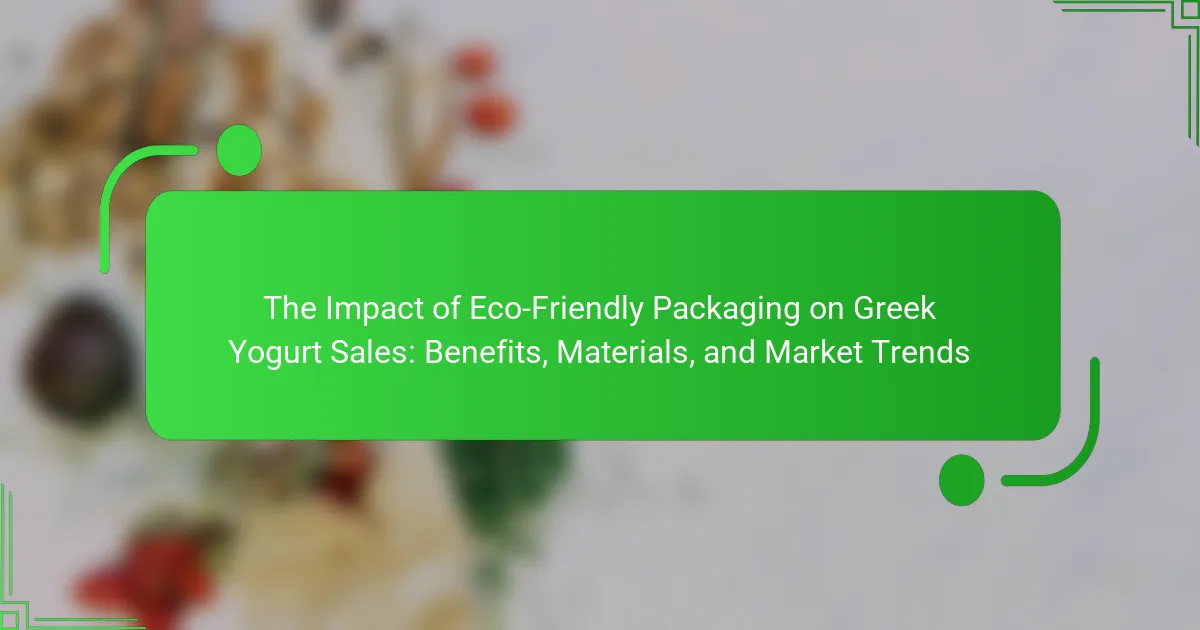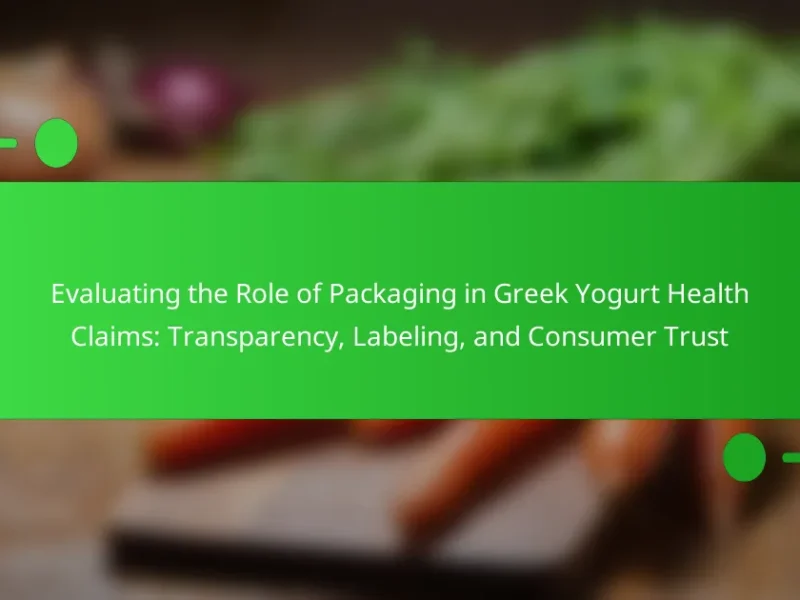Eco-friendly packaging significantly influences Greek yogurt sales, as consumers increasingly favor sustainable products. Research shows that 74% of shoppers are willing to pay a premium for eco-friendly packaging, which enhances brand loyalty among environmentally conscious customers. Greek yogurt brands adopting materials such as biodegradable plastics, recycled paper, and glass are experiencing sales increases of 10-20%. The current market trend reflects a growing demand for sustainable packaging solutions driven by heightened environmental awareness and regulatory pressures to reduce plastic waste. This article examines the benefits, materials, and market trends associated with eco-friendly packaging in the Greek yogurt industry.
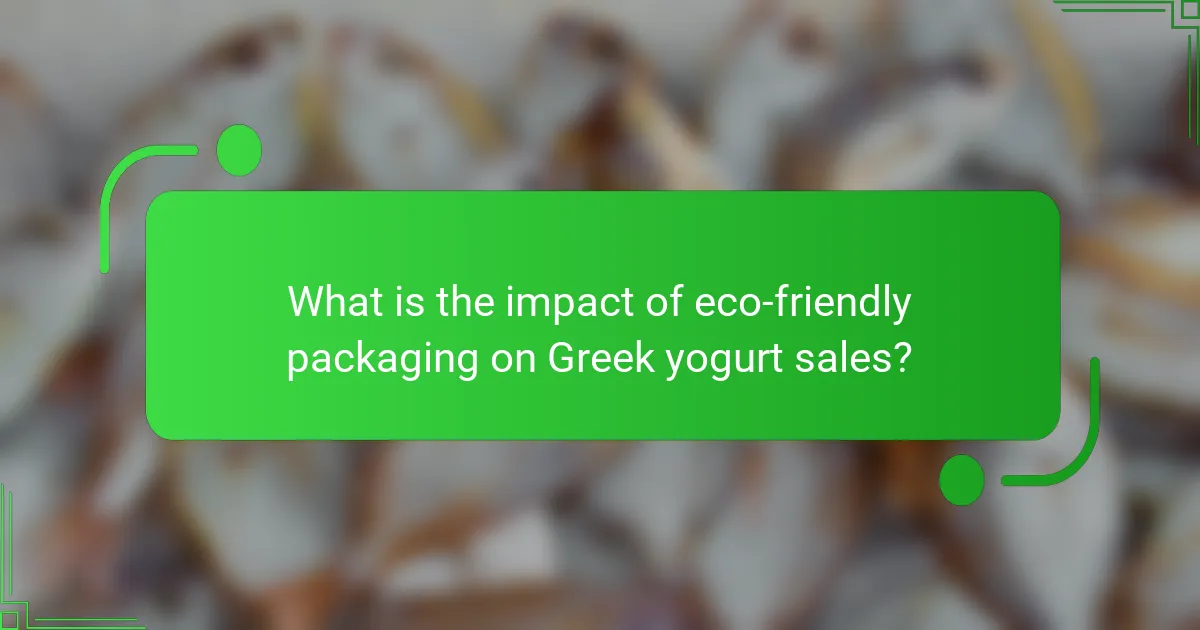
What is the impact of eco-friendly packaging on Greek yogurt sales?
Eco-friendly packaging positively impacts Greek yogurt sales. Consumers increasingly prefer sustainable products. Research indicates that 74% of shoppers are willing to pay more for eco-friendly packaging. This trend boosts brand loyalty among environmentally conscious customers. Brands adopting eco-friendly packaging often see a sales increase of 10-20%. The demand for sustainable packaging aligns with growing environmental awareness. Consequently, Greek yogurt brands that prioritize eco-friendly options can enhance their market position.
How does eco-friendly packaging influence consumer purchasing decisions?
Eco-friendly packaging significantly influences consumer purchasing decisions by enhancing brand perception. Consumers increasingly prefer products with sustainable packaging. A survey by Nielsen found that 73% of global consumers are willing to change their consumption habits to reduce environmental impact. Eco-friendly packaging also builds trust and loyalty among consumers. Brands using such packaging are often perceived as more responsible and ethical. Furthermore, eco-friendly packaging can differentiate products in a crowded market. This differentiation can lead to increased sales and market share. Consumers are more likely to choose products that align with their values regarding sustainability.
What are the psychological effects of eco-friendly packaging on consumers?
Eco-friendly packaging positively influences consumer psychology. Consumers often perceive eco-friendly packaging as a sign of quality and care. This perception can enhance brand loyalty. Research shows that 72% of consumers are more likely to purchase products in sustainable packaging. The emotional connection to environmental responsibility drives purchasing decisions. Eco-friendly packaging can evoke feelings of satisfaction and pride in consumers. This aligns with their values and beliefs about sustainability. Brands that adopt eco-friendly practices may benefit from increased sales and a stronger market presence.
How does branding with eco-friendly packaging affect Greek yogurt sales?
Branding with eco-friendly packaging positively affects Greek yogurt sales. Consumers increasingly prefer sustainable products. A study by Nielsen found that 66% of global consumers are willing to pay more for sustainable brands. Greek yogurt brands using eco-friendly packaging attract environmentally conscious shoppers. This packaging can enhance brand loyalty and market differentiation. Additionally, eco-friendly packaging can lead to positive brand perception. Brands like Chobani have reported increased sales after adopting sustainable practices. Overall, eco-friendly packaging aligns with consumer values, driving sales in the Greek yogurt market.
What are the benefits of using eco-friendly packaging for Greek yogurt?
Eco-friendly packaging for Greek yogurt provides several benefits. It reduces environmental impact by minimizing plastic waste. Biodegradable materials break down faster than traditional plastics. This aligns with consumer preferences for sustainable products. Research shows that 73% of consumers prefer brands using eco-friendly packaging. Additionally, eco-friendly packaging can enhance brand image. It reflects a company’s commitment to sustainability. This can lead to increased customer loyalty and sales. Moreover, eco-friendly packaging often uses less energy in production. This contributes to lower carbon emissions. Overall, eco-friendly packaging supports both environmental goals and market trends.
What environmental benefits are associated with eco-friendly packaging?
Eco-friendly packaging reduces environmental impact by minimizing waste and pollution. It often uses biodegradable or recyclable materials. These materials decompose more quickly than traditional plastics. This leads to less landfill accumulation. Eco-friendly packaging also lowers carbon emissions during production. For example, using plant-based materials can reduce greenhouse gases. Additionally, it encourages sustainable practices in manufacturing and consumption. This shift promotes a circular economy, where materials are reused. Overall, eco-friendly packaging contributes significantly to environmental conservation.
How does eco-friendly packaging enhance product freshness and shelf life?
Eco-friendly packaging enhances product freshness and shelf life by utilizing materials that are often more breathable and moisture-resistant. These materials help maintain optimal humidity levels within the packaging. This controlled environment reduces spoilage and extends the product’s usability. Additionally, eco-friendly packaging often incorporates natural preservatives, which can further inhibit microbial growth. Research indicates that products in eco-friendly packaging can have a shelf life extension of 10-30% compared to conventional packaging. This is particularly beneficial for perishable items like Greek yogurt, where freshness is crucial for consumer satisfaction.
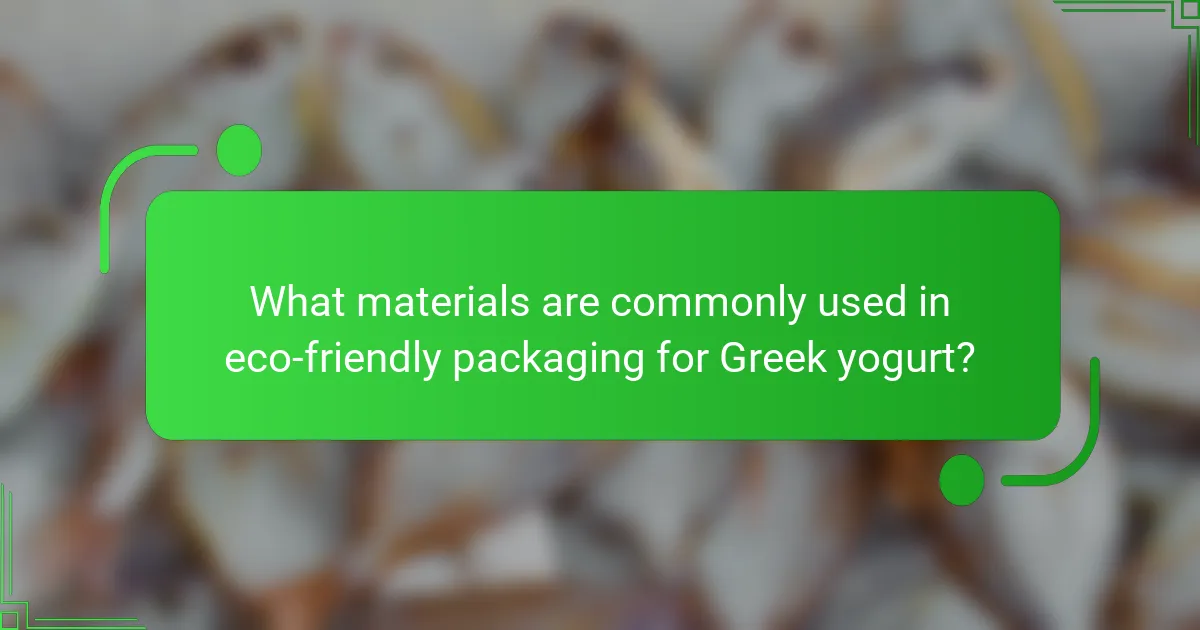
What materials are commonly used in eco-friendly packaging for Greek yogurt?
Eco-friendly packaging for Greek yogurt commonly uses materials such as biodegradable plastics, recycled paper, and glass. Biodegradable plastics break down naturally, reducing environmental impact. Recycled paper is often used for cartons, promoting sustainability by reusing materials. Glass packaging is recyclable and can be reused multiple times. These materials help minimize waste and lower carbon footprints. The use of these eco-friendly options aligns with consumer demand for sustainable products. Research indicates that consumers are increasingly favoring brands that prioritize environmentally responsible packaging.
What are the most popular sustainable materials for yogurt packaging?
The most popular sustainable materials for yogurt packaging include biodegradable plastics, glass, and paperboard. Biodegradable plastics are made from renewable resources and can decompose in natural environments. Glass is fully recyclable and does not leach chemicals, making it a safe option. Paperboard is lightweight and made from renewable materials, offering a lower carbon footprint. Many yogurt brands are shifting to these materials due to increasing consumer demand for eco-friendly packaging solutions. Research shows that sustainable packaging can enhance brand loyalty and boost sales in the yogurt market.
How does biodegradable packaging compare to traditional materials?
Biodegradable packaging decomposes naturally, unlike traditional materials that persist in the environment. Traditional materials, such as plastic, can take hundreds of years to break down. In contrast, biodegradable options often decompose within months under the right conditions. This rapid breakdown reduces landfill waste and environmental pollution. Biodegradable packaging is made from renewable resources, such as plant-based materials. Traditional packaging is typically derived from fossil fuels. Studies show that using biodegradable materials can significantly lower carbon footprints. For example, a life cycle assessment indicated a 30% reduction in greenhouse gas emissions when switching to biodegradable packaging.
What innovations in packaging materials are currently emerging?
Biodegradable packaging materials are currently emerging as a significant innovation. These materials decompose naturally, reducing environmental impact. Examples include plant-based plastics and compostable films. Another innovation is the use of recycled materials in packaging. This approach promotes sustainability by repurposing waste. Smart packaging technologies are also gaining traction. These include sensors that monitor product freshness. Additionally, minimalistic packaging designs are being adopted to reduce material usage. These innovations collectively aim to enhance sustainability in the packaging industry.
How do different materials impact the perception of Greek yogurt quality?
Different materials significantly impact the perception of Greek yogurt quality. Packaging materials influence consumer expectations regarding freshness and taste. For instance, glass packaging often conveys a premium quality perception. Consumers associate glass with better preservation of flavor and texture. In contrast, plastic may be perceived as less premium. This perception can affect purchasing decisions. Research indicates that eco-friendly materials can enhance brand reputation. Brands using sustainable packaging may be viewed as more trustworthy. Thus, the choice of packaging material directly correlates with consumer perceptions of quality.
What role does packaging material play in consumer trust and brand loyalty?
Packaging material significantly influences consumer trust and brand loyalty. High-quality packaging conveys a sense of reliability and safety. Consumers often associate durable packaging with product quality. Eco-friendly packaging can enhance brand reputation and attract environmentally conscious buyers. Studies show that 73% of consumers are willing to pay more for sustainable packaging. This willingness fosters brand loyalty among eco-aware customers. Furthermore, transparent packaging allows consumers to see the product, increasing trust. Brands that prioritize packaging sustainability can differentiate themselves in a competitive market. Thus, effective packaging plays a crucial role in building consumer relationships.
How can manufacturers choose the right packaging material for their products?
Manufacturers can choose the right packaging material by evaluating product requirements, environmental impact, and consumer preferences. First, they must assess the physical properties needed for protection and preservation. This includes barrier properties against moisture, light, and oxygen. Second, they should consider the sustainability of materials. Eco-friendly options like biodegradable plastics or recycled materials can enhance brand image. Third, manufacturers should analyze cost-effectiveness and supply chain logistics. This ensures that chosen materials are economically viable. Lastly, they must gather consumer feedback on packaging preferences. Research indicates that 74% of consumers are willing to pay more for sustainable packaging (Source: Nielsen, 2018).
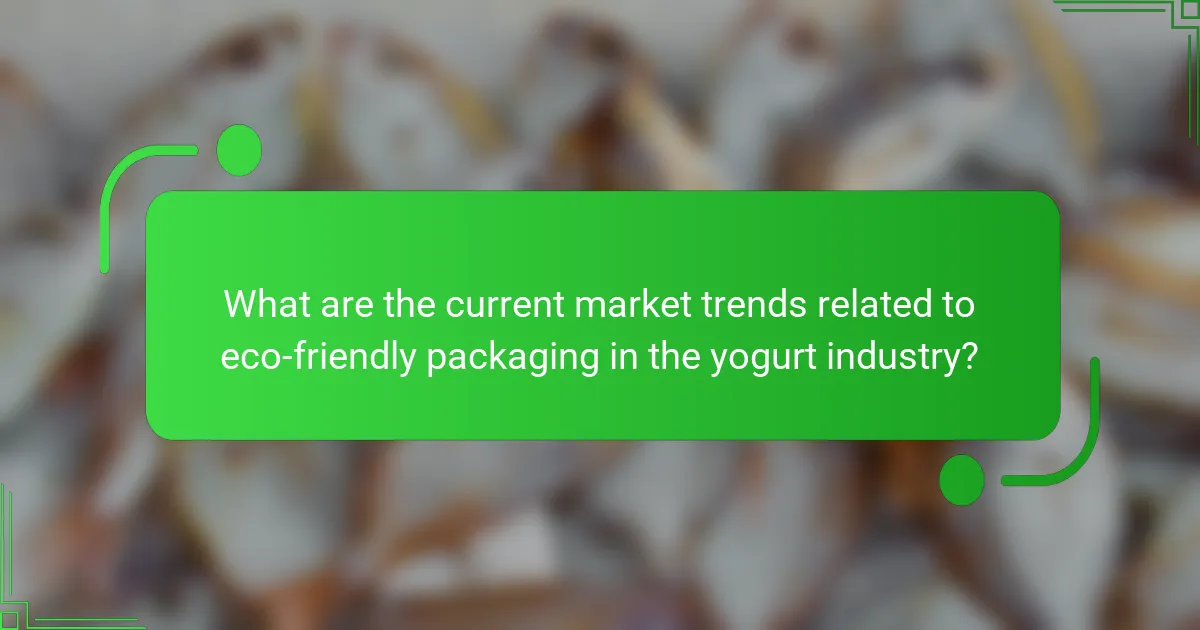
What are the current market trends related to eco-friendly packaging in the yogurt industry?
Current market trends in eco-friendly packaging for the yogurt industry include increased consumer demand for sustainable materials. Brands are shifting towards biodegradable and recyclable packaging options. Many yogurt companies are adopting plant-based plastics and compostable containers. This trend is driven by growing environmental awareness among consumers. Research indicates that 74% of consumers prefer brands with eco-friendly packaging. Additionally, regulatory pressures are pushing companies to reduce plastic waste. Innovations in packaging technology are also enhancing sustainability efforts. Overall, the yogurt industry is increasingly aligning with eco-conscious practices.
How is consumer demand for eco-friendly products changing the yogurt market?
Consumer demand for eco-friendly products is significantly transforming the yogurt market. This shift is driving yogurt brands to adopt sustainable practices. Many companies are now using biodegradable packaging materials. Research indicates that 70% of consumers prefer brands with eco-friendly packaging. This preference is influencing purchasing decisions and brand loyalty. As a result, yogurt manufacturers are innovating to meet these expectations. They are investing in sustainable sourcing and production methods. The trend is expected to continue growing as environmental awareness increases.
What statistics illustrate the growth of eco-friendly packaging in the yogurt sector?
The eco-friendly packaging market in the yogurt sector has seen significant growth. In 2021, the global eco-friendly packaging market was valued at approximately $400 billion. It is projected to reach $600 billion by 2027, growing at a CAGR of around 8%. Specifically, in the yogurt segment, eco-friendly packaging adoption increased by 25% from 2019 to 2021. According to a recent survey, 70% of consumers prefer brands that use sustainable packaging. This shift is driven by rising environmental awareness and demand for biodegradable materials. The yogurt industry is responding with innovative packaging solutions like plant-based containers and recyclable materials.
How are competitors adapting to these market trends?
Competitors are adapting to eco-friendly packaging trends by implementing sustainable materials. Many brands are shifting to biodegradable and recyclable packaging options. This change aims to meet consumer demand for environmentally responsible products. Research indicates that 73% of consumers prefer brands that use eco-friendly packaging. Competitors are also investing in innovative designs that reduce material usage. Additionally, some companies are promoting their sustainability efforts through marketing campaigns. This strategy enhances brand loyalty among environmentally conscious consumers. Overall, these adaptations reflect a significant shift in the yogurt market towards sustainability.
What challenges do brands face when implementing eco-friendly packaging?
Brands face several challenges when implementing eco-friendly packaging. One significant challenge is the higher cost of sustainable materials. Eco-friendly options often have a premium price compared to traditional packaging. This can impact profit margins for brands.
Another challenge is sourcing reliable suppliers. Many brands struggle to find suppliers that can consistently provide eco-friendly materials. This inconsistency can disrupt production schedules.
Additionally, consumer perception presents a challenge. Some consumers may not trust the effectiveness of eco-friendly packaging. Brands must invest in education and marketing to change these perceptions.
Regulatory compliance is also a concern. Brands need to navigate various regulations regarding materials and recycling. This can complicate the packaging process.
Finally, the durability of eco-friendly packaging can be an issue. Sustainable materials may not always provide the same level of protection as traditional options. Brands must balance sustainability with functionality to meet customer expectations.
What are the cost implications of switching to eco-friendly packaging?
Switching to eco-friendly packaging often incurs higher initial costs. Materials like biodegradable plastics or recycled paper can be more expensive than traditional packaging. For example, a study by Smithers Pira indicated that sustainable packaging can cost 10-30% more. However, these costs can be offset by consumer demand for eco-friendly products. Many consumers are willing to pay a premium for sustainable packaging. Additionally, brands may experience cost savings in waste management and potential tax incentives for using green materials. Over time, economies of scale may reduce costs as eco-friendly options become more mainstream.
How can brands overcome consumer skepticism regarding eco-friendly claims?
Brands can overcome consumer skepticism regarding eco-friendly claims by ensuring transparency in their practices. They should provide clear, verifiable information about their sourcing and production processes. Using third-party certifications can enhance credibility. For instance, certifications like USDA Organic or Fair Trade signal commitment to eco-friendly practices. Brands can also engage in storytelling that highlights their sustainability journey. This approach connects emotionally with consumers and builds trust. Furthermore, sharing measurable outcomes, such as reduced carbon footprints or waste reduction statistics, can substantiate claims. Research indicates that 83% of consumers prefer brands that are transparent about their environmental impact. Thus, consistent communication and evidence-based claims are essential for overcoming skepticism.
What best practices should brands adopt for eco-friendly packaging in Greek yogurt?
Brands should adopt sustainable materials for eco-friendly packaging in Greek yogurt. This includes using biodegradable or compostable materials. Brands can also implement recyclable packaging designs. Utilizing minimal packaging reduces waste significantly. Incorporating refillable containers encourages reuse among consumers. Clear labeling on sustainability practices builds consumer trust. Collaborating with suppliers for eco-friendly options enhances overall sustainability. Regularly assessing packaging lifecycle impacts ensures ongoing improvement.
The primary entity of this article is eco-friendly packaging in relation to Greek yogurt sales. The article examines the positive impact of sustainable packaging on consumer purchasing decisions, brand loyalty, and market trends, highlighting that 74% of shoppers are willing to pay more for eco-friendly options. It discusses various materials used in eco-friendly packaging, such as biodegradable plastics and recycled paper, and the psychological effects these materials have on consumer perceptions of quality and trust. Additionally, the article addresses the challenges brands face when implementing eco-friendly practices and provides best practices for adopting sustainable packaging solutions in the yogurt industry.
